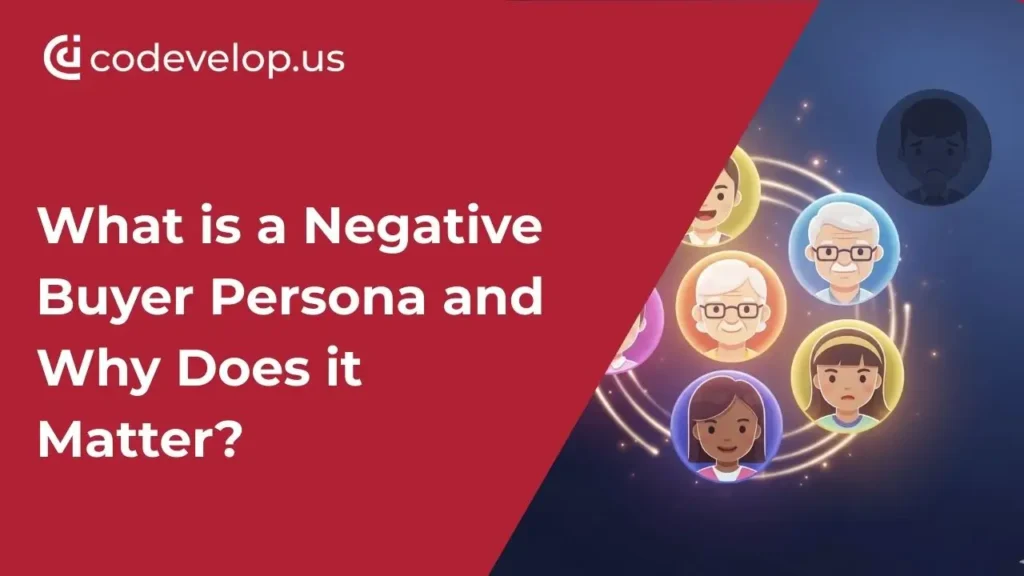Have you ever looked at your analytics dashboard and thought, “Wait, why are these people spending so much time on my website, but nothing is happening?”
They browse multiple pages. They check out your videos. They even download free resources or sign up for your newsletter. The high-intent visitor is doing everything you would expect based on their behavior. When it comes time to convert, sign up for a plan, make a purchase, or become a customer, they just disappear into thin air.
Frustrating, isn’t it?
There are some people who will appear to be interested in your company, but they won’t ever turn into customers. Some people may look like prospects, but they will never really turn into customers. And if you keep targeting them, you’ll waste time, money, and a lot of energy.
This is where negative buyer personas come in.
What is a Negative Buyer Persona?
A buyer persona is a semi-fictional profile of a customer that represents your ideal customer, based on data, research, and real-life behavior of your ideal customer.
But here’s the catch: your product or service isn’t for everyone. And trying to market to everyone is one of the fastest ways to burn your budget.
That’s why marketers create the opposite: negative buyer personas. Also known as exclusionary personas, these are the profiles of people you don’t want to attract.
Think of them as the “wrong audience” people who either:
- Never buy despite showing interest
- It costs too much to acquire or support
- Constantly drain your resources
- Or simply aren’t in a position to benefit from what you offer
While your positive personas show you who to go after, your negative personas warn you who to avoid.
Common Traits of a Negative Buyer Persona
So, how do you know when someone fits this “wrong audience” category? Negative buyers tend to share a few telltale characteristics. They might:
- Have no authority to make a purchase decision
- Ghost your marketing campaigns and emails
- Push back against new features, updates, or add-ons
- Struggle with payments or cause billing headaches
- Quickly drop off after a free trial
- Leave unhappy reviews even when the product does what it promises
Of course, the specifics will depend on your business. For example, a B2B SaaS company might label free-trial users who never upgrade as a negative persona. A clothing retailer might tag serial returners or coupon-only buyers as negative.
The point is: you need to know who’s wasting your team’s time, so you can refocus on the people who will actually stick around.
Why Bother with Negative Personas?
If you’re wondering whether this is just another marketing buzzword, let’s clear that up. Negative personas can save your business in multiple ways.
1. Stop Chasing Red Flags
Ever seen a bull go after a red flag, even though it’s colorblind? The bull charges anyway just because the flag is there.
That’s how businesses sometimes act with bad-fit leads. You see someone engaging with your content, and you throw discounts, deals, and endless follow-ups at them, only to realize they were never going to buy in the first place.
Negative personas help you spot these red flags before you waste your energy.
2. Refine Your Ideal Personas
Defining who you don’t want makes it easier to understand who you do want. It sharpens your picture of your ideal customer.
For instance, if you know that “budget-only shoppers” are a negative persona, it reinforces that your ideal persona values quality over discounts.
3. Smarter Marketing Campaigns
Marketing is already tough. The last thing you want is to spray your message everywhere and hope it lands.
The use of negative personas will allow you to filter out audiences that will not convert. This will help as a marketer to be hyper-focused on the people who actually matter. The result? Better engagement, more conversions, and less wasted spend.
4. Budget Protection
Forrester reported that marketers lose about 21% of their budget due to bad customer data. A big part of that loss comes from targeting the wrong people.
The sooner you know who to avoid spending money on, the more money you have to spend on the right things. You will also be able to stretch your budget further. Your sales team will spend less time chasing dead-end leads, and your support team will avoid headaches from frustrated customers who shouldn’t have bought in the first place.
5. Build a Healthier Community
It’s not that all negative personas are bad. A few may not be paying customers, such as students researching your brand or fans who adore it but cannot afford it, but they may still share your content and talk about it. That’s brand awareness you cannot ignore. It’s important to identify them as supporters instead of customers so that you don’t waste sales resources trying to convert them.
How to Build a Negative Buyer Persona
Creating exclusionary personas doesn’t have to be complicated. Here’s a step-by-step approach you can use:
Step 1: Collect Data
Start with your sales, marketing, and support teams. They already know the patterns. Sales can tell you about leads that always stall. Support can tell you about customers who drain resources. Marketing can tell you about audiences that never engage.
Analytics tools like Google Analytics and your CRM are also helpful. Look for:
- Visitors who spend time but don’t convert
- High abandonment rates
- Repeated free-trial sign-ups without upgrades
Step 2: Talk to Customers
Data gives you numbers, but conversations give you context. Interview past customers who stopped using your product or people who returned it. Send out surveys with open-ended questions like:
- What made you stop using our product?
- Were you disappointed with anything specific?
- Did our product help you reach your goals?
These responses will show you patterns that hard data can’t capture.
Step 3: Create the Profile
Once you have your insights, it’s time to sketch out the persona. Give them a name, a description, and a list of behaviors.
For example:
- “Free Trial Fiona”: Loves testing products but never upgrades.
- “Coupon Carl”: Buys only during promotions and returns items often.
The clearer you define them, the easier it becomes to exclude them from campaigns.
Step 4: Keep it Updated
Here’s the thing: people change. Someone who wasn’t a fit last year might now have the budget or the need for your product.
That’s why it’s important to revisit and refine your personas regularly. Don’t let them sit in a document collecting dust.
Using Negative Personas the Smart Way
Okay, so now you know who to avoid. But how do you actually use that knowledge?
- Email segmentation: Exclude negative personas from nurture campaigns so they don’t drag down your open rates.
- Paid ads: Adjust targeting filters so you don’t waste money on unqualified clicks.
- Messaging clarity: Be upfront about who your product is not for. Customers appreciate honesty.
- Product decisions: Use the data to avoid building features that only serve negative personas.
Lessons from Real-World Missteps
Remember Microsoft’s Zune? It was supposed to compete with the iPod but ended up flopping. Why?
They didn’t read the market correctly. Apple already had loyal users, and the Zune wasn’t unique enough to pull them away. If Microsoft had recognized “already-committed Apple users” as a negative persona, they might have redirected their focus instead of spending millions chasing the wrong crowd.
That’s exactly how exclusionary personas help you avoid repeating costly mistakes.
Final Thoughts
So, what is a negative buyer persona? It’s not just a fancy marketing term. It’s a practical tool that helps you filter out the noise.
By knowing who not to target, you free up space, time, and budget for the people who do matter. The result? Stronger campaigns, happier customers, and a healthier bottom line.
At the end of the day, marketing isn’t about appealing to everyone; it’s about finding the right someone. And sometimes, the smartest move is knowing when to say “no.”
Ready to attract the right customers and stop wasting resources on the wrong ones? 🚀 Partner with Codevelop to build smarter buyer personas and boost your marketing ROI.


